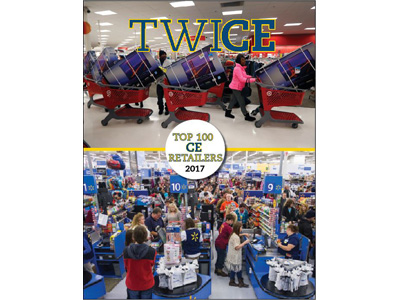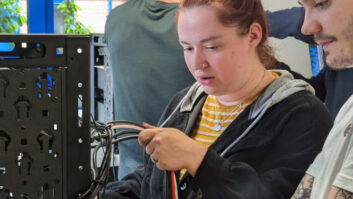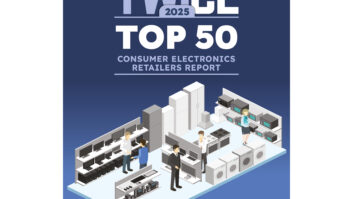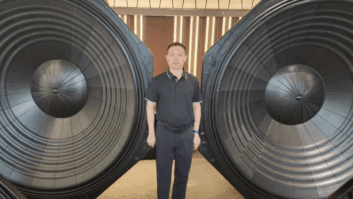
2016 was another rough-and-tumble year for tech retail, as a slow transition to smart CE and the black-hole-like pull of Amazon put a damper on industrywide growth.
Nevertheless, according to TWICE’s latest annual Top 100 CE Retailers Report, the business’ 100 largest dealers managed to buck the upheavals of U.S. retail at large and remained in the plus column with a 1.5 percent gain in tech revenue last year.
Related: Find out how to obtain a copy of the 2017 TWICE Top 100 CE Retailers Report
That amounted to a record $137 billion in total sell-through for the registry, which is produced with research partner The Stevenson Company and accounts for more than 90 percent of all U.S. CE retail sales combined.
But it didn’t come easy. Amid the recovering economy, merchants’ improving digital skill sets turned up the competitive heat last year. Still on the watch list were Sears and hhgregg — only one of which remains in play — while Conn’s too hit a snag as its in-house credit business felt the pain of cash-strapped customers.
For mobile retailers another stumbling block arrived last fall as hot-as-fire Samsung was forced to recall its flammable Note7 phones.
And while Best Buy turned a corner as operational improvements and e-commerce catch-ups led to sales and earnings gains, consumers put spending on hold on the eve of the holiday selling season while a contentious presidential race drew their rapt attention.
Against that backdrop was a mixed bag of winners and losers. The aforementioned Best Buy remained the nation’s No. 1 CE chain, with $30.7 billion in tech sales. But despite a surging digital business, revenue growth, particularly for legacy tech, was modest within its 1,300-plus stores and the company closed out the year just north of flat, with a 0.8 percent increase in CE sales.
In contrast, Amazon continued to consolidate its No. 2 position and further closed the gap with Best Buy by posting a staggering 25 percent sales spike that brought it within $2 billion of the industry leader. As industry veteran and Sharp Home Electronics sales and marketing senior VP Peter Weedfald noted, the e-tailer’s product descriptions, photos and videos, customer reviews, diverse marketplace sellers, and same-day and Sunday deliveries represent “a perfect storm” of disintermediation.
Related: The Peter Principle: Retail’s Revival Begins At Home
Most, however, did not fare nearly as well, with deep double-digit declines attributed to chains like GameStop (-18 percent), Sears (-21 percent), RadioShack (-27 percent), hhgregg (-28 percent), and GameStop’s Simply Mac (down 32 percent).
In those instances, the freefall was structural: GameStop is between new console platforms and faces increased competition from vendor-direct downloads; Sears is actively dismantling its CE business; RadioShack has reentered Chapter 11 and is aggressively closing stores; hhgregg is liquidating; and Simply Mac shut a third of its store base.
But how to explain the downturns for others on the list, like independent stalwart Jetson TV & Appliance, which, at -48 percent, suffered the registry’s steepest decline?
Most A/V-based dealers are still reeling from the commoditization of TV, which sucked the profit from a core, tent-pole category. And while price controls and fully-featured 4K jumbo displays have helped, penetration can’t equal the glory days of tube-to-flat panel and analog-to-HD conversions.
As a result, retailers are scrambling to find higher-margin alternatives to TV. Many have turned to appliances, furniture and mattresses, all large-footprint products that further erode CE sales as floor space is reallocated.
See also: 11 Dealers Leading The Appliance Charge
And yet many Top 100 denizens still managed to eke out solid gains, by opening new stores, upgrading existing ones, or serving a unique niche, like GameStop’s ThinkGeek collectibles chain.
Others, like ProSource dealers Bjorn Dybdahl in San Antonio (up 18 percent), and Bob Cole of World Wide Stereo in Philly (ahead 30 percent), are riding a resurgence in new-home construction and remodels. As ProSource CEO Dave Workman told TWICE, “Business is very good for our guys where homebuilding is strong. They’re scrambling to keep up with demand for installations. They’re booked into summer and posting some scary numbers. For two or three years, during the housing bust, they could barely hold on to survive. Now, consumers are spending more money and adding on more things.”
“Remember,” he continued, “when the recession hit there was no business in networking, shades, LED lighting or premium two-channel audio. That’s huge, huge volume now and our business is incredible. It’s a testament to our dealers adapting to a constantly-changing business, while hhgregg and RadioShack file for bankruptcy.”
Still, driven by sales growth at Amazon and the coast-to-coast reach of the big-box mass merchants, the immutable forces of contraction continue to compress the industry. Startlingly, fully 84 percent of all Top 100 sales were controlled by the 10 largest CE retailers last year, including No. 3 Walmart, No. 4 Apple and fifth-place Costco. That’s up almost 2 percentage points from 2015, and, looking back a decade for perspective, up from 72 percent in our 2007 report.













